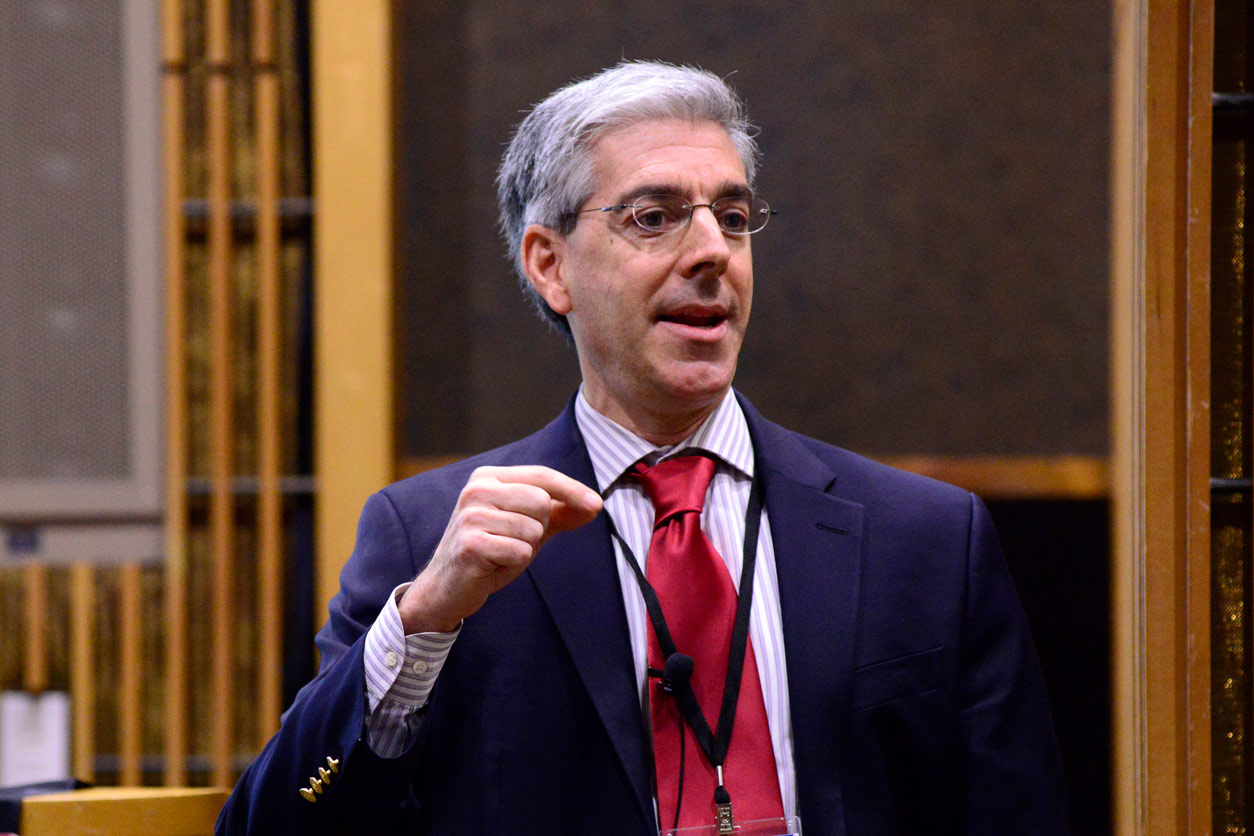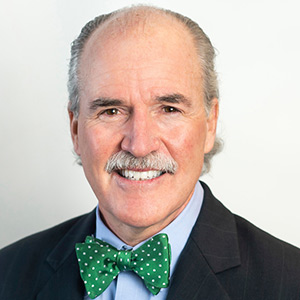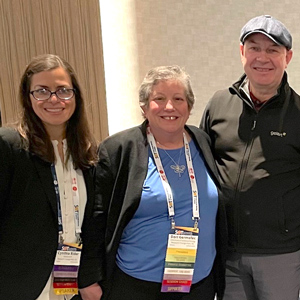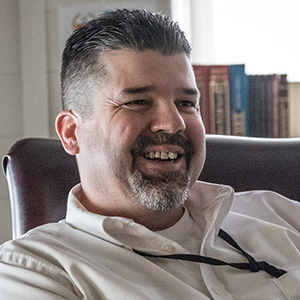John Balbus, M.D., who has served as senior advisor for public health at NIEHS since 2009, was elected to the National Academy of Medicine (NAM) on Oct. 18. In addition, he was recently appointed interim director of the newly established Office of Climate Change and Health Equity, which is housed in the U.S. Department of Health and Human Services (HHS).
Balbus represents HHS as a principal of the U.S. Global Change Research Program, and he co-chairs the program’s Interagency Cross-cutting Group on Climate Change and Human Health. He is a member of numerous scientific professional societies and serves as a reviewer for several medical journals. In 2020, Balbus kicked off an NIEHS seminar series on climate, environment, and health, which is sponsored by the institute’s Global Environmental Health program.
Environmental Factor recently spoke with Balbus to learn more about his climate change and human health efforts and to provide readers with a glimpse into his career and achievements.
 Balbus, shown here speaking at NIEHS in 2014, also is an adjunct associate professor at Johns Hopkins Bloomberg School of Public Health and a professorial lecturer at the George Washington University Milken Institute School of Public Health. (Photo courtesy of Steve McCaw / NIEHS)
Balbus, shown here speaking at NIEHS in 2014, also is an adjunct associate professor at Johns Hopkins Bloomberg School of Public Health and a professorial lecturer at the George Washington University Milken Institute School of Public Health. (Photo courtesy of Steve McCaw / NIEHS)Science and policy intersect
Environmental Factor: What came to mind when you found out you had been elected to NAM?
John Balbus: I feel my election is part of a collective intention of the Academy to become an influential force on climate action from a health perspective. I have a new opportunity to contribute to that as a member, after many years of involvement on this topic with the National Academies of Sciences, Engineering, and Medicine, both as a sponsor and subject matter expert.
EF: NAM emphasized your work developing the first risk assessment approaches and your efforts at the intersection of science and policy. Can you talk about those aspects of your career?
JB: I was drawn to risk assessment as a practicing physician who was very interested in the biological mechanisms of how environmental pollution harms people’s health. While doing my residency in occupational and environmental medicine, I had the opportunity to help write the first guidance documents on how a country could assess its vulnerability to climate change in terms of health, ultimately for the United Nations Environment Programme. It was a fascinating challenge to bring together toxicology risk assessment principles with the new field of microbial risk assessment and then add in exposures to extreme weather and climate change as well.
In 2002, I joined the advocacy group Environmental Defense Fund [EDF] as chief health scientist, where I hoped to influence policies and regulations that would reduce people’s exposures and protect health. At EDF, I had the privilege of working to strengthen protections for well-known exposures and risks such as diesel exhaust and particulate matter air pollution. Also, I was able to partner with industry and the international standards organizations to get out ahead of nanotechnology and understand potential risks of related products before people could get exposed and harmed.
Climate change and equity
 Earlier this year, Balbus and Fogarty International Center Senior Scientist Joshua Rosenthal, Ph.D., spoke with NIEHS and National Toxicology Program Director Rick Woychik, Ph.D., about the importance of collaboration in addressing climate change-related health issues. (Photo courtesy of Steve McCaw / NIEHS)
Earlier this year, Balbus and Fogarty International Center Senior Scientist Joshua Rosenthal, Ph.D., spoke with NIEHS and National Toxicology Program Director Rick Woychik, Ph.D., about the importance of collaboration in addressing climate change-related health issues. (Photo courtesy of Steve McCaw / NIEHS)EF: What are your proudest career moments or achievements?
JB: I am proud of the suite of climate change and health products I have helped to create during the past decade. Most of this has been done with partners from NIEHS and several other agencies through my roles as the U.S. Global Change Research Program principal for HHS and the co-chair of the Interagency Crosscutting Group on Climate Change and Human Health [see sidebar]. The interagency group was chartered just as I started up at NIEHS, and it was intended to be a pilot in end-to-end science, meaning connecting the research enterprise to end users.
EF: What is it like in the new HHS Office of Climate Change and Health Equity?
JB: One of the most frustrating things about working on climate change and health during the past decades has been the lack of urgency among decision-makers in taking the necessary actions to prevent severe climate change. That is why it is extremely exciting and gratifying to be part of the pivot from research and assessment activities to public health and environmental actions that can directly address the root causes of both climate change and health disparities.
It also is exciting to do so with guidance and leadership from people such as HHS Secretary Xavier Becerra and Admiral Rachel Levine, M.D., the HHS Assistant Secretary for Health. Our team is embarking on an ambitious path. We aim to strengthen health protections for populations vulnerable to climate change, and we will work with the country’s health care delivery sector to reduce its greenhouse gas emissions and make it more resilient to climate change.
We are also collaborating with parts of HHS that work on social determinants of health and health disparities. Our goal is to make sure that we align climate actions to the maximum extent possible and address poor health and subsequent climate change health risks. So far, the work is intense, and large in scope and complexity, but it is an enormous privilege to be given the opportunity to build a team to do this kind of work.
Mentors provide inspiration
EF: Were there mentors or colleagues who helped you grow in your career?
JB: I’ve had the privilege of being mentored for more than 30 years by Dr. Howard Frumkin. He was a new faculty member at the University of Pennsylvania when I was in my third year of medicine residency. Frumkin provided inspiration for me to go into the field of occupational and environmental medicine, and he has been my role model as a thinker, an inspiring speaker, and a visionary leader in environmental public health ever since. Also, we now have the wonderful coincidence of being in the same group of new members of the National Academy of Medicine.
Richard Pepino, my high school chemistry teacher, inspired me to become a biochemistry major in college. Coincidentally, after leaving teaching for a highly successful career at the U.S. Environmental Protection Agency, Mr. Pepino ended up at the NIEHS-funded University of Pennsylvania Superfund Research and Training Program, leading their Research Translation Core. I’ve had the pleasure of meeting up with him in recent years at our Partnerships for Environmental Public Health meetings.
Finally, I am eternally grateful for the vision and mentorship of Linda Birnbaum, Ph.D., [former director of NIEHS and the National Toxicology Program], who hired me into the federal government and who has supported my work in climate change and health at the institute.
Helping the most vulnerable
EF: Climate change and human health — so many factors, so many issues. What do you think is most pressing? Where do you see the field going in the next few years?
JB: The most pressing need is to mobilize individuals and society to face the challenge urgently and comprehensively. Health professionals have an important role to play because of our understanding of behavioral change and health promotion.
Going forward, I am hopeful there will be more focus on how extreme heat, wildfires, and severe weather events affect the most vulnerable. From acute interventions to long-term recovery, there will be more emphasis on health equity and ensuring those most affected get resources they need to improve their quality of life rather than just return to deprived circumstances and higher risks.
(Kelley Christensen is a contract writer and editor for the NIEHS Office of Communications and Public Liaison.)









